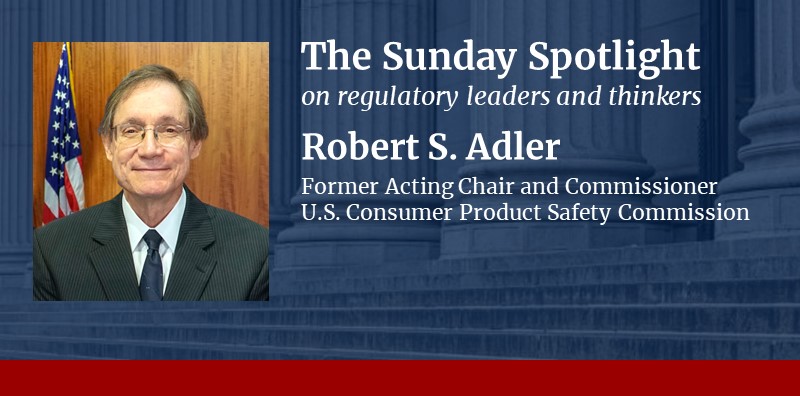
Robert S. Adler, former CPSC Commissioner, discusses the evolution of regulatory approaches to consumer safety and protection.
In a recent conversation with The Regulatory Review, Robert S. Adler, a former Commissioner of the U. S. Consumer Product Safety Commission (CPSC), reflects on both the history and current state of consumer product safety regulation in the United States.
Adler explains why he views the Consumer Product Safety Improvement Act of 2008 as having provided helpful additional protections for consumers, while also changing some structural and organizational aspects of the CPSC that hampers its ability to act swiftly. Adler also emphasizes the need for the CPSC to use artificial intelligence tools to make better use of the mass of safety-related data it has available to it, while nevertheless being cautious about over-reliance on cost-benefit analysis when making regulatory decisions.
Adler served as a CPSC Commissioner from 2009 to 2021, serving as Acting Chair of the agency during his last two years on the Commission. Previously, he served as a professor of Legal Studies at the University of North Carolina (UNC) where he was the Luther Hodges, Jr., Scholar in Ethics and Law at Chapel Hill’s Kenan-Flagler Business School. He also served as the Associate Dean of the MBA Program and as Associate Dean for the School’s Bachelor of Science in Business Administration Program.
An award-winning teacher, Adler taught courses at UNC in business law, business ethics, business-government relations, and negotiation. His research focused on product safety and liability, regulation, commercial law, medical malpractice, and negotiation. In 2004, he received the Gerald Barrett Faculty Award for outstanding teaching and service to the MBA Program.
Earlier in his career, he served as an attorney-advisor to two CPSC commissioners, legislative counsel on a House subcommittee, and deputy attorney general in Pennsylvania. Most recently, he taught at the Wharton School of the University of Pennsylvania.
The Regulatory Review is pleased to share the following exchange with former Commissioner Adler.
TRR: In an essay published last year in The Regulatory Review, you wrote that the CPSC was established in the early 1970s during a time that came to be known as the “Consumer Decade.” What decade or era of consumer protection would you say the United States is in now?
Adler: It is a mixed bag. I say this because just as we experience business cycles in the economy, we also experience regulatory cycles in the body politic, as University of California, Berkeley professor David Vogel identified over 30 years ago in his book, Fluctuating Fortunes: The Political Power of Business in America.
I believe that regulatory cycles oscillate between regulation and deregulation depending on changing circumstances such as politics, the economy, business scandals, and the strength of consumer and citizen advocacy organizations. At the moment, we seem to be in a period of polarization and impasse about consumer protection, with highly charged feelings on different sides of the issues, which all too often thwarts progress.
I have always argued that consumer safety should not become politicized and should not be the exclusive domain of any political party or philosophy. Although I remain hopeful, I fear that current trends are not positive.
TRR: How did the Consumer Product Safety Improvement Act of 2008 change or shape the CPSC?
Adler: The Consumer Product Safety Improvement Act of 2008 (CPSIA) stands as the most significant change in CPSC authority and funding since the passage of the original act creating the Commission in 1972. Drafted in response to headlines about lead-laden toys flooding the United States, CPSIA provides, among other things, enhanced authority to the agency to write safety standards for infant products, regulate certain chemical hazards such as lead and phthalates, and require third parties certify the safety of manufacturers’ products. The act also increased civil penalties, expanded the agency’s budget authority, and set up a publicly available database of product safety complaints.
Of course, no new law can solve all of an agency’s problems. CPSIA failed to streamline the agency’s cumbersome rulemaking procedures and did not repeal major restrictions on the CPSC’s ability to share critical safety information with the public. And, one of my pet peeves: CPSIA expanded the number of Commissioners from three to five. In addition to adding too much leadership to a tiny agency, this change added hundreds of thousands of dollars to the CPSC’s strapped budget and has increased delays in agency decision-making.
On balance, I would say that CPSIA significantly increased safety protection for many consumers, but it fell short of what I would like to see in substantive and procedural reforms.
TRR: Because of the size of the CPSC and the nature of its work, the agency often has to work closely with private sector organizations. How does the CPSC manage this private sector coordination to ensure that the public’s interest remains at the center of its mission?
Adler: No public agency can operate effectively without broad engagement with, and support from, its many stakeholders. The CPSC’s statutory authority is premised on this principle. Specifically, to issue safety rules—particularly for children’s products—the CPSC is required by law to work with and include input from voluntary standards groups, as well as consumer advocacy groups and independent safety experts.
Unfortunately, despite its mandate to work with outside groups, the CPSC too often finds consumer input to be lacking. I have long urged the agency to take stronger action to seek consumer involvement. To facilitate this, I received Commission approval several years ago to add an Office of Consumer Ombudsman, which seeks to enlist more consumers in standards writing. But more work needs to be done here.
TRR: In which areas are the CPSC’s duties most evolving as the agency confronts emerging and future challenges?
Adler: I see at least two major challenges. First, the agency has to find ways to use artificial intelligence and machine learning to expand its data-gathering capabilities. The amount of safety data available can be overwhelming to a lightly funded agency like the CPSC. What is needed is the ability to scrutinize, on an automated basis, reams of information to identify emerging hazards before injuries and deaths accumulate.
Second, given the vast array of new chemicals being placed in consumer products, the CPSC will have to find innovative ways to address chemical hazards given its extremely small budget. One of the ways that the agency has responded to this issue is to address broad categories of chemicals, rather than address them one by one. For example, the CPSC is currently working with the National Academy of Sciences to examine the hazards of a family of chemicals called organohalogens rather than regulating hundreds of separate chemicals on a one by one, “whack-a-mole” basis.
TRR: Cost-benefit analysis and the value of a statistical life are tools of economic analysis often used by regulatory agencies. As a former CPSC Commissioner, what are your views about incorporating these kinds of metrics into regulatory decision-making?
Adler: The CPSC is required under most, but not all, of its statutory authority to conduct cost-benefit analyses before promulgating safety standards. I recognize that such analyses can inform decision-making, but I find a rigid adherence to such analyses unhelpful given how much unquantifiable information—such as fairness, dignity, and equity—needs to be incorporated into agency rulemaking. I take issue with the expansion and idealization of cost-benefit analyses over the years. Cost-benefit analyses can be useful in identifying onerous and ill-considered regulations to a point. Beyond that, when deciding whether to implement safety rules, I support a more holistic approach that applies common sense to rulemaking.
I have always felt, for instance, that rules that address hazards to young children should not be governed strictly with “by-the-numbers” analyses. Children are highly vulnerable, involuntary risk-takers and they deserve extra protection, even when a rigidly mathematical economic analysis might point to “no action.”
I would repeat a caveat that I have said elsewhere. Too often, the cost-benefit analysis focuses only on the short-term costs of safety rules—which are often high—and ignores the likelihood that costs will soon drop as industry improves its production capabilities and economies of scale kick in.
The Sunday Spotlight is a recurring feature of The Regulatory Review that periodically shares conversations with leaders and thinkers in the field of regulation and, in doing so, shines a light on important regulatory topics and ideas.



